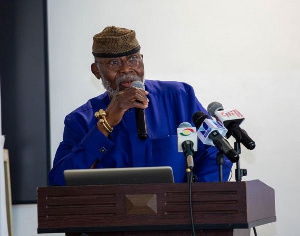Opinions of Wednesday, 7 May 2008
Columnist: Ossei, Nana Yaw
Achieving Middle-Income Status: What are the options?
Part 1
“If Africa is ever to break the chains of poverty and move along the road to prosperity,
it must industrialise”
If Ghana is ever to break the chains of poverty and move along the road to prosperity, it must
industrialise. Despite five decades of independence, Ghana has failed to establish a viable industrial base
and continues to rely on the export of raw materials. Whereas other countries and most recently South
Korea, Singapore, Malaysia and Taiwan have successfully shifted from primary industries toward
manufacturing and knowledge-based industries, export of raw commodities is still the mainstay of the
Ghanaian economy and by extension, most African economies. Raw commodities constitute the lowest
stage of transformation into products sold on the market and, hence have the lowest profit margin. The
Ghanaian economy is highly vulnerable to the vagaries of weather and boom-or-bust business cycle on
the international commodities market. The economic growth of all industrialised and newly-industrialised
countries has come via the industrialisation route hence, what is stopping Ghana from joining the global
trend towards industrialisation?
One of the many reasons for Ghana and for that matter Africa’s economic under-performance as
compared to countries in Asia such as Singapore, Taiwan and South Korea is our failure to industrialise
and establish sustainable export-markets by developing the manufacturing capability to compete in global
markets. Over the past four decades, the newly industrialised countries invested heavily in human capital,
physical infrastructure, private domestic investment, an effective public sector, selective industrial
promotion, a better educated labour-force, technology, modernised agriculture, high levels of domestic
financial savings and importantly, nurturing the growth of their private sectors-all of which were
prerequisites to building a healthy industrial sector. Ghana which is richly endowed with mineral
resources and ample manpower, should vigorously pursue export diversification strategies where the
emphasis should be to shift from resources and agricultural exports to manufactured exports and from
simple labour-intensive industries to more capital-intensive activities. Ghana cannot prosper in today’s
competitive global economy without achieving industrialisation.
It is clear now, if there has been any doubt that, the road to Ghana’s and Africa’s salvation is via
industrialisation. Without the use of machinery and modern know-how, Ghana will continue to produce at
subsistence level and will never achieve the output surplus essential for a general improvement of living
standards. Today, 50 years after independence, Ghana and by extension Africa, is still a supplier of raw
commodities to the rest of the world. In value terms, raw commodities are right at the bottom of the
chain that forms the price structure of products. The price of commodities themselves, as readers will
know, fluctuate widely over the seasons and depend on the demand for them from manufacturers
abroad. Africans and Ghanaians have little if any control over the price of their coffee, cocoa, tea, copper,
or for that matter, gold. Raw materials begin to acquire substantial commercial value only when they are
worked on and rendered into the type of products for which there is a wide market. The industrial
revolution of Europe, which came about with the invention of machinery and a system of financing that
allowed large projects to be undertaken, changed forever mankind’s concepts of production. Suddenly, as
a result of mass production, a stream of goods began to issue from factories. The more that was
produced, the less it cost to produce. Europe, then America and finally Asia entered into an
unprecedented era of prosperity. Africa’s role was, by and large, simply to supply the raw materials for
ever-hungry factories of the north. Some of these items eventually found their way back to Africa but at
inflated prices and for the consumption only of the well to do. This is still generally the case. Africa’s
Manufacturing Value Addition today is less than one percent of that of the world.. The industrial revolution
which has now evolved into the information technology revolution, only lightly brushed Africa.
Industrial development in Ghana seems to be given less weight than it deserves and yet, it is well
documented in various literature that industrialisation has several advantages. In the long run, industrial
development other than the primary sector will take Ghana to middle-income-status. Industrialisation is a
process by which not only the manufacturing sector becomes to account for a large share of GDP and
employment but, also the industrial structure is transformed to include the production of goods and
services requiring higher technological capabilities, more sophisticated worker skills and greater
managerial competence. Industrialisation does not happen by itself because; it needs to be initiated by
economic agents. Late industrialising nations such as Ghana can use private enterprise to drive
industrialisation but, only with the overt assistance of the State. Diversification away from the primary
sector towards manufacturing reduces risks and vulnerability to the long-term deteriorating commodity
terms of trade and the associated loss in real income. Unlike the primary sector, the industrial sector has
more forward and backward linkages with other sectors especially agriculture and mining.
Industrialisation contributes significantly to employment creation if the right technique is chosen and
industrialisation has relatively great possibility of technological transfer and adaptation and creation of
technology. In general, industrialisation ensures economic independence in the long run. International
trade is a key companion of industrialisation just as trade is a source of industrial growth and industrial
growth can help Ghana expand on her trading prowess. Ghana needs to diversify away from long
standing trade patterns which have involved excessive reliance on exports of raw materials and semi-
processed goods, and on the traditional comparative advantages of raw materials and unskilled labour.
Greater emphasis on higher value added products and specialization would reap rewards. However,
market access is critical for the success of such an approach.
It is important to notice that development in areas of health, education, gender empowerment,
environmental sustainability and infrastructure are essential if productive sectors are to grow, create
employment which results in sustained development. Africa’s manufacturing exports are quite small
totalling some $80 billion dollars which is equivalent to the total manufacturing exports for Malaysia or
Mexico alone. By contrast, Asian countries have the greatest share of manufactures in their exports which
can be attributed to a combination of high skill level and low natural resources. In Africa, only Mauritius
has a similar combination of high skill level and low natural resources and it exports manufactures in the
same share as the emerging East Asian economies. Ghana and by extension Africa, have registered slow
growth in the sector of industrial development due to lack of proper and enough build up of social and
technological capabilities. Wide consensus prevails on the problems concerning industrialisation in Ghana
which is characterised by low productivity, insufficient competitiveness on price and quality, lack of
efficiency, lack of financial resources, lack of infrastructure, lack of a skilled and educated workforce, a
lack of visionary and articulate national strategic industrial policy, a poor research and development
strategy, lack of an adoption of continuous improvements and innovation programmes, no national
innovation system, poor linkages with domestic suppliers of inputs and technical service facilities and lack
of generation and application of Science and Technology and a host more. Incidentally, African Heads of
States have agreed to push R&D spending in their respective countries to 1% of GDP by 2010 and
shockingly, of all the 54 African nations, only South Africa is on target to meet the target by 2010. In
East Asia, R&D played a vital role in their success of achieving industrialisation in less than 30 years and
yet in Africa, we play lip service to R&D.
Rapid technical innovation is changing the structure of manufacturing industries towards more
sophisticated, skills-intensive activities, which is precisely where African countries is weakest. The
underlying problem is not that Ghana and Africa is unwilling to liberalise and embrace globalisation but
that, there has been little competitive response to these forces. Few industries have upgraded so
technical efficiency of African manufacturers compares unfavourably with foreign competitors. Foreign
investment in Ghana’s manufacturing sector is currently low which is not surprising given that domestic
investment is equally low. One key to more foreign investment is for there to be more domestic
investment. Foreign investors will be interested in a sector once they observe local firms who are better
informed about local opportunities investing. China, India, Malaysia and Singapore are living testimonies
of the fact that, bolstering local productive capacities is a sine qua non for economic buoyancy and yet,
none of these countries is as endowed as Ghana in terms of natural resource. Malaysia is yet another
nation once on the same if not worse pedestal with Ghana. But the country realised that, the future
would be determined by what a nation can produce for both local and export markets. The government
took to heavy industrialisation as exemplified by the investments in mining, construction and later in the
high-tech sector. By mid 1970s and 1990s, Malaysia was already one of the fastest growing economies of
the world. The economy was further boosted in 1991 when the government launched its vision 2020
programme envisioned to put Malaysia into the developed nation’s bracket by 2020. That programme
precipitated heavy government spending in local infrastructure especially in the Kuala Lumpur area. As
you read this, manufactured goods account for nearly 80 percent of the country’s exports by value with
unemployment pruned to below three percent. Major products range from palm oil, timber, tin, rubber,
and petroleum to electronic goods among others. That is the same Malaysia that came to Ghana in the
early 1960s to learn the tricks of agriculture.
During the early 1960s, a fierce debate raged in Japan about whether to continue supporting its
automotive industry because, Japan’s first foray into exporting cars into the US market had proved
spectacularly unsuccessful. Rather, Japanese free-trade economists (Apostles of the free market) argued,
Japan should specialise in what it was best at thus, exporting silk and abandon attempts to develop more
advanced industries. If Japan had followed this advice it would not now be one of the richest countries in
the world in per capita terms. The story of Japan’s rapid industrialisation through industrial policy and
that of other East Asian tigers is relatively well known. Although there have been numerous examples of
industrial policy failures, what is less well known is that there are almost no historical examples of
countries that have industrialised without an active industrial and trade policy.
An increasing awareness of the basic problems inhibiting Ghana’s drive towards industrialisation
reinforces the need for an integrated industrial strategy aimed at building fixed investments and human
resources. Ghana must begin its own industrial revolution. Ghana and Africa has one huge advantage
over highly industrialised nations in that, it does not have to invent machinery or methods but rather, all
it needs to do is to acquire equipment and learn how the equipment works. Of course it is not as simple
as that. However, industrial production requires an industrial mind-set, it requires sophisticated marketing
and distribution strategies and it needs large amounts of capital.. Again, these are neither new nor
esoteric concepts. It is fairly easy to learn the ropes. The real problem comes in applying what is learnt.
You cannot achieve industrialisation without forward planning and you cannot have forward planning
without a strong developmental state in terms of public institutions which are transparent, accountable
and efficient. Industrialisation calls for a network of integrated enterprises and large injections of capital.
In Ghana, in spite of the numerous banks that have trooped into Ghana, the fact still remains that, 18
million Ghanaians out of a population of 22 million do not have bank accounts so the question arises as
to where the large injections of capital will come from to invest in industrial enterprises and SMEs? Ghana
needs to learn lessons from Singapore as to how the Singaporeans were able to give a practical meaning
to the concept of “property owning democracy” and secondly, how China is able to mobilize domestic
savings through state banks totalling 45 percent of their GDP in 2007.
Industrialisation is based on the application of scientific methods and reason. Bold new thinking is needed
for restructuring the industrial sector to achieve efficiency and export competitiveness. With industrial
development, Ghana can take decisive steps towards full-throttle competition in the global market.
Clrearly, the way forward is for Ghana to develop a strong and diversified industrial base, capable of
withstanding commodity market volatility and investing in technological advanced infrastructure to boost
productivity growth. However, building Ghana’s industrial capabilities is a decade-long, possibly I hesitate
to say even generational, if the right and correct choices are not made today. It is unlikely to be archived
during a simple five-year development plan. Industrialisation cannot take place in Ghana without an
active support of the State and the rational that, government is just a facilitator cannot and will not form
the basis of Ghana’s industrialisation. Government needs to go beyond just being a facilitator. All the
presidential aspirants should spend a little time thinking about the conditions that promote or inhibit
industrialisation because, obtaining the machinery and methodology is the easiest part; the most difficult
is changing a culture which has been poisonous to industry.
Entertainment










